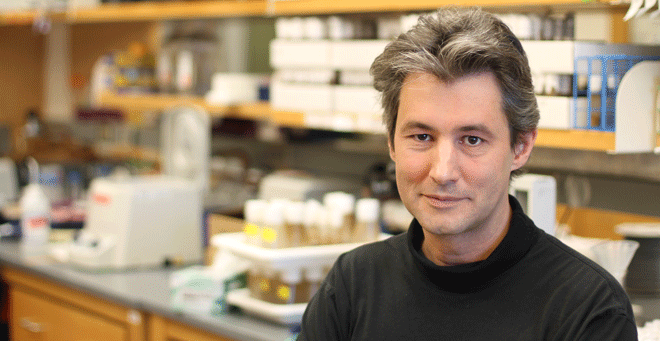 |
|
|
Patrick Emery, PhD |
Patrick Emery, PhD, professor of neurobiology, has received a five-year, $4.1 million Maximizing Investigators' Research Award (MIRA) from the National Institute of General Medical Sciences to study the molecular, genetic and neural mechanisms underlying circadian rhythms and their synchronization by environmental clues such as light and temperature cycles.
Part of the National Institutes of Health’s outstanding investigator award program, MIRA is designed to encourage investigators to embark on ambitious, long-term projects of unusual potential. The award provides extended funding that enables researchers to devote more time and energy to working in the lab and less time writing and revising grant applications.
“This is a very prestigious award, directed to the most productive investigators studying crucial biomedical questions,” said Vivian Budnik, PhD, Worcester Foundation for Biomedical Research Chair, and chair and professor of neurobiology. “This funding allows Dr. Emery the stability and flexibility to pursue new directions in his research as opportunities arise.”
Circadian rhythms time most bodily functions, from basic metabolism to behavior, so that they are synchronized and optimized with the time of day. This has a profound impact on physiology and behavior. Disruption of circadian rhythms seriously impacts human health and has been linked to a great number of diseases. For example, mood and metabolic disorders, specific cancers and gastro-intestinal diseases are more frequent in off-shift workers.
Using the fruit fly Drosophila as a model system, Emery will study the fundamental principles underlying circadian rhythms and their synchronization to the day–night cycle. Specifically, he will use genetics, molecular biology and neurobiology to determine the molecular mechanisms governing how circadian pacemakers receive and respond to light and temperature inputs, and how these inputs are integrated by circadian pacemakers. He will also investigate how the network of neurons controlling circadian rhythms inside the Drosophila brain connects environmental cues such as light and temperature to various circadian behaviors. Finally, there is growing evidence that multiple steps governing gene expression are critical for circadian rhythms. Emery will look at the mechanisms regulating circadian mRNA metabolism and translation.
“We expect our work to provide an integrative picture of the mechanisms generating, controlling and synchronizing circadian rhythms in fruit flies,” said Emery. “Because the basic mechanisms underlying circadian rhythms are remarkably well conserved in animals—from Drosophila to mammals—we anticipate that our work will also prove important for our understanding of mammalian circadian rhythms, and might thus ultimately impact our ability to treat diseases associated with disrupted circadian clocks.”
Related story on UMassMedNow:
Gene linked to circadian rhythm identified